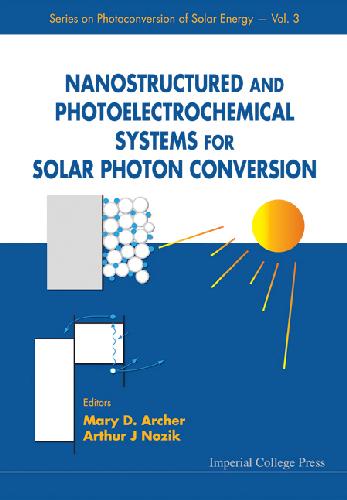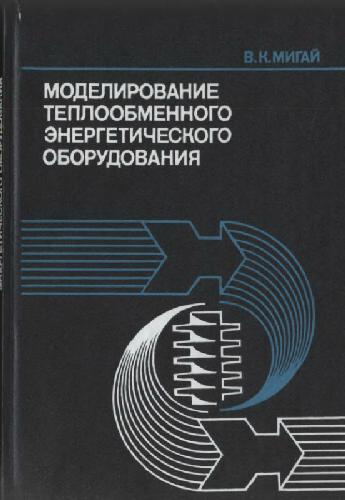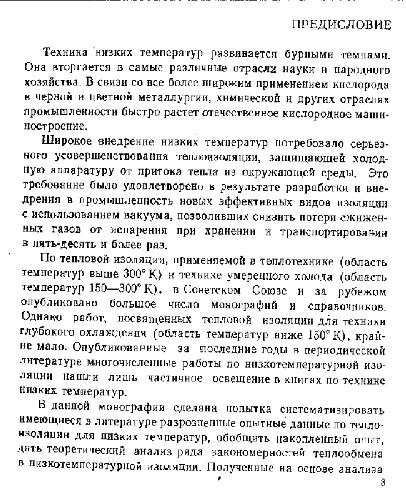Mary D. Archer1-86094-255-5, 978-1-86094-255-6
Contents: Overview (M D Archer); Fundamentals in Photoelectrochemistry (R J D Miller & R Memming); Fundamentals and Applications of Quantum-Confined Structures (A J Nozik); Fundamentals and Applications in Electron-Transfer Reactions (M D Archer); Fundamentals in Metal-Oxide Heterogeneous Photocatalysis (N Serpone & A V Emeline); Inorganic Extended-Junction Devices (R K?¶nenkamp); Organic Donor Acceptor Heterojunction Solar Cells (J J Benson-Smith & J Nelson); Dye-Sensitised Mesoscopic Solar Cells (M Gr?¤tzel & J R Durrant); Semiconductor/Liquid Junction Photoelectrochemical Solar Cells (S Maldonado et al.); Photoelectrochemical Storage Cells (S Licht & G Hodes); Measuring Ultrafast Photoinduced Electron-Transfer Dynamics (X Ai & T Lian); Experimental Techniques in Photoelectrochemistry (L M Peter & H Tributsch).
Table of contents :
CONTENTS……Page 8
About the authors……Page 12
Preface……Page 20
1.1 Themes……Page 22
1.2 Historical perspective……Page 27
1.3 Extremely thin absorber (ETA) cells……Page 31
1.4 Organic solar cells……Page 33
1.5 Dye-sensitised solar cells (Grätzel cells)……Page 37
1.6 Regenerative solar cells……Page 39
1.7 Future prospects……Page 44
App. The vacuum scale of electrode potential and the concept of the 1A solution Fermi level……Page 45
1A.2 Absolute electrode potentials……Page 46
1A.3 Absolute electrode potential of the SHE……Page 48
1A.4 The solution Fermi level……Page 49
1A.5 Vacuum scale of electrode potential……Page 50
References……Page 51
2.1 Introduction……Page 60
2.2 Photophysics of semiconductors and semiconductor particles……Page 62
2.2.1 Field effects……Page 67
2.3.1 Bulk three-dimensional semiconductors……Page 76
2.3.2 Layered semiconductors: quasi-two-dimensional systems……Page 89
2.3.3 Quasi-one-dimensional semiconductors……Page 92
2.3.4 Nanoscale-structured semiconductors……Page 93
2.3.5 Midgap state effects: surface-state trapping……Page 99
2.4.1 Energy levels at the semiconductor–liquid interface……Page 105
2.4.2 Majority-carrier processes……Page 111
2.4.3 Minority-carrier processes……Page 116
2.4.4 The quasi-Fermi level concept for electron-transfer processes……Page 120
2.4.5 Interfacial charge-transfer dynamics……Page 124
2.4.6 Dye sensitisation……Page 133
2.5 Conversion of solar energy……Page 141
2.5.1 Electrochemical photovoltaic cells……Page 142
2.5.2 Photoelectrolysis of water……Page 145
2.5.3 Conversion efficiencies……Page 146
2.5.4 Competition between redox reactions and anodic decomposition……Page 149
2.6 Photocatalysis……Page 151
2.7 Summary……Page 153
Editorial note……Page 154
References……Page 155
3.1 Introduction……Page 168
3.2 Quantisation effects in semiconductor nanostructures……Page 172
3.2.1 Synthesis of semiconductor nanostructures……Page 174
3.2.2 Energy levels in quantum wells, superlattices and quantum dots……Page 179
3.3.1 Quantum wells and superlattices……Page 184
3.3.2 Quantum dots……Page 185
3.4.1 Quantum wells and superlattices……Page 188
3.4.2 Quantum dots……Page 193
3.5 High conversion efficiency via multiple exciton generation in quantum dots……Page 197
3.5.2 Electron–hole pair (exciton) multiplication in quantum dots……Page 198
3.5.3 Theory of multiple exciton generation……Page 202
3.5.4 Thermodynamic calculations of conversion efficiency in MEG QD solar cells……Page 206
3.6.1 Photoelectrodes composed of quantum dot arrays……Page 211
3.6.2 Quantum dot-sensitised nanocrystalline TiO2 solar cells……Page 213
3.6.3 Quantum dots dispersed in organic semiconductor polymer matrices……Page 214
Acknowledgements……Page 215
References……Page 216
4.1 Introduction……Page 230
4.2 Historical perspective……Page 234
4.3 Thermodynamics of ET and PET reactions……Page 239
4.4 Classical Marcus theory……Page 244
4.4.1 The energy surface for reaction……Page 245
4.4.2 The rate expression……Page 248
4.4.3 The reorganisation energy……Page 251
4.5 Semiclassical theories of nonadiabatic electron transfer……Page 253
4.5.1 Donor–acceptor coupling……Page 254
4.5.2 Nuclear tunnelling……Page 256
4.5.3 Semiclassical rate expressions……Page 257
4.6 Electron transfer in donor–bridge–acceptor supermolecules……Page 259
4.6.1 Superexchange……Page 261
4.6.2 Evaluation of the transfer integral TDA……Page 263
4.6.3 Distance dependence of superexchange ET rates……Page 265
4.6.4 Hopping conduction……Page 266
4.7 Electrochemical electron transfer……Page 268
4.7.1 Metal electrodes……Page 271
4.7.2 Semiconductor electrodes……Page 277
4.7.3 Electrochemical electron transfer through bridged assemblies……Page 281
4.8.1 Rate control by solvent dynamics……Page 282
4.9 Optimisation of photoinduced electron transfer in photoconversion……Page 284
App. 4A Solution density-of-states functions……Page 286
App. 4B Derivation of high-temperature limit Marcus rate equation for homogeneous electron transfer using density-of-states approach……Page 287
References……Page 289
5.1 Introduction……Page 296
5.2 The complex science underlying metal-oxide photocatalysis……Page 298
5.2.1 Small-size semiconductor particles: optical properties……Page 300
5.2.2 Implications for photocatalysis……Page 311
5.2.3 The InterParticle Electron Transfer (IPET) process……Page 312
5.2.4 The nature of the valence-band hole……Page 314
5.2.5 The nature of photocatalysis……Page 316
5.2.6 Turnover quantities……Page 320
5.2.7 Further notions of photocatalysis……Page 326
5.3.1 Photoinduced processes in solids……Page 331
5.3.2 Nature of solids……Page 333
5.3.3 Photophysical events in solids……Page 335
5.3.4 Deposition of silver clusters on TiO2 particles……Page 343
5.3.5 Charge conservation in solids……Page 344
5.3.6 Photoexcitation of colour centres……Page 346
5.4 Challenges in heterogeneous photocatalysis……Page 350
5.4.1 Activity of a photocatalyst (photonic efficiency, quantum yield)……Page 351
5.4.2 Simple primary surface reactions……Page 361
5.4.3 Colour centres and the band model of semiconductors……Page 363
5.5.1 Modelling……Page 366
5.5.2 Presence of an electric field in the photocatalyst particle……Page 375
5.5.3 Selectivity of photocatalysts……Page 386
5.6 Evidence for a gas/solid surface reaction being photocatalytic……Page 395
5.7 Concluding remarks……Page 402
References……Page 403
6.1 Introduction……Page 414
6.2.1 Structure and operation……Page 419
6.2.2 Transport considerations……Page 421
6.2.4 Optical considerations……Page 422
6.2.5 Overall quantitative description……Page 423
6.3.1 Substrates……Page 424
6.3.2 Transfer of nanostructures and manipulation of the morphology……Page 429
6.3.3 Semiconductor deposition on deeply structured substrates……Page 431
6.3.4 Void-filling growth……Page 438
6.4.1 Junction formation, band line-up and charge distribution……Page 440
6.4.2 Transport in nanostructured materials……Page 446
6.4.3 Optical properties……Page 452
6.5 Devices……Page 455
6.5.1 CuInS2-based solar cells……Page 456
6.5.2 CdTe-based solar cells……Page 457
6.5.3 Quantum dot-based ETA cells……Page 460
6.6.1 Novel photovoltaic concepts……Page 462
6.7 Summary……Page 464
References……Page 465
7.1.1 The case for plastic photovoltaic material……Page 474
7.1.2 Properties of molecular semiconductors and comparisons with conventional semiconductors……Page 475
7.2.1 Fundamental processes in organic semiconductors……Page 478
7.2.2 Molecular photovoltaic device types……Page 481
7.3 Donor–acceptor bilayer devices……Page 482
7.4.1 Principles of bulk heterojunction devices……Page 486
7.4.2 Progress with polymer : fullerene bulk heterojunction devices……Page 488
7.4.3 Progress with polymer : polymer bulk heterojunction devices……Page 491
7.4.4 Hybrid polymer : inorganic nanostructure bulk heterojunction devices……Page 492
7.5.1 Device physics of molecular heterojunction solar cells……Page 494
7.5.2 Goals for improved device performance……Page 497
7.6.1 Increasing light absorption……Page 499
7.6.2 Increasing the open-circuit voltage by control of interfacial energy levels……Page 502
7.6.3 Improving charge transport……Page 504
7.6.4 Optimising morphology……Page 505
7.6.5 Improving electrodes……Page 507
7.6.6 Improving device stability……Page 508
7.7 Summary……Page 510
References……Page 511
8.1 Introduction……Page 524
8.2 Historical background……Page 525
8.3.1 Device configuration……Page 526
8.3.2 Device fabrication……Page 528
8.3.3 Energetics of operation……Page 529
8.3.4 Kinetics of operation……Page 533
8.4.1 Panchromatic sensitisers……Page 536
8.4.2 Opportunities for performance improvement……Page 539
8.4.3 Tandem cells……Page 540
8.4.4 Stability……Page 542
8.4.6 Quantum dots as sensitisers……Page 544
8.4.7 Mesoporous oxide film development……Page 545
8.4.8 Molecular engineering of the interface……Page 546
8.5 Solid-state dye-sensitised cells……Page 547
8.6 Pilot production of modules, outdoor field tests and commercial DSSC development……Page 548
Acknowledgements……Page 551
References……Page 552
9.1 Introduction……Page 558
9.2.1 Interfacial energetics……Page 560
9.3 Non-aqueous solvents……Page 569
9.4.1 Metallisation of the surface……Page 572
9.4.2 Adsorption of solution species……Page 577
9.4.3 Covalently-attached surface groups……Page 581
Acknowledgements……Page 590
References……Page 595
10.1 Introduction……Page 612
10.1.1 Charge separation, injection and storage……Page 613
10.2 Comparative solar energy storage processes……Page 615
10.2.2 Photochemical storage……Page 616
10.2.3 Semiconductor photoredox storage……Page 618
10.3.1 Two-electrode configurations……Page 621
10.3.2 Three-electrode configurations……Page 623
10.4.1 Improvement of the photoresponse of a photoelectrode……Page 624
10.4.2 Effect of the electrolyte……Page 625
10.4.4 Combined optimisation of storage and photoconversion……Page 628
10.5.1 PECS cells with solution-phase storage……Page 632
10.5.2 PECS cells including a solid-phase storage couple……Page 635
10.5.3 PECS cells incorporating intercalation or other changes in the electrodes……Page 640
10.5.4 PECS cells with novel solid-phase storage……Page 641
10.5.5 PECS coupled to external fuel cell……Page 642
10.6 High-efficiency multiple-bandgap cells with storage……Page 643
10.7 Conclusions……Page 646
References……Page 647
11.1 Introduction……Page 654
11.2.1 Time-resolved fluorescence……Page 656
11.2.2 Transient absorption spectroscopy……Page 659
11.2.3 New experimental approaches……Page 663
11.3.1 Theoretical model……Page 666
11.3.2 Dependence on relative energetics……Page 670
11.3.3 Dependence on electronic coupling……Page 673
11.3.4 Ultrafast biphasic electron injection from N3 to TiO2……Page 675
11.3.5 Dependence on the semiconductor……Page 677
11.4 Summary……Page 680
References……Page 681
12.1 Introduction……Page 696
12.2.1 Single- frequency admittance measurements (Mott–Schottky plots)……Page 697
12.2.2 Electrochemical impedance spectroscopy (EIS)……Page 702
12.3.1 Photocurrent spectroscopy……Page 704
12.3.2 Photovoltage spectroscopy……Page 710
12.3.3 Light-induced microwave reflectance changes……Page 712
12.3.4 Potential-modulation-induced microwave reflectance……Page 717
12.4.1 In-situ UV/visible methods……Page 718
12.4.2 In-situ infrared methods……Page 719
12.4.3 Luminescence spectroscopy……Page 721
12.5.1 Time-resolved photocurrent and photovoltage measurements……Page 723
12.5.2 Time-resolved spectroscopic measurements……Page 725
12.5.3 Time-resolved microwave reflectivity measurements……Page 726
12.6.1 Electrolyte electroreflectance spectroscopy……Page 727
12.6.2 Calorimetric measurements……Page 730
12.7.1 Intensity-modulated photocurrent spectroscopy……Page 733
12.7.2 Intensity-modulated photovoltage spectroscopy……Page 737
12.7.3 Light-modulated microwave reflectivity……Page 738
12.8 Imaging techniques……Page 741
12.10 Differential mass spectrometry (DEMS)……Page 744
12.11 Combination of electrochemistry with vacuum spectroscopy……Page 746
References……Page 748
I Fundamental Constants……Page 758
II Useful Quantities and Conversion Factors……Page 759
III List of Symbols……Page 760
IV Acronyms and Abbreviations……Page 764
Index……Page 768







Reviews
There are no reviews yet.